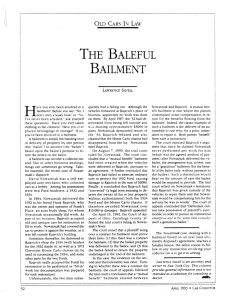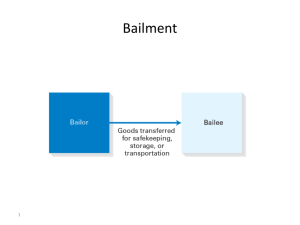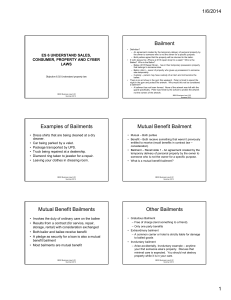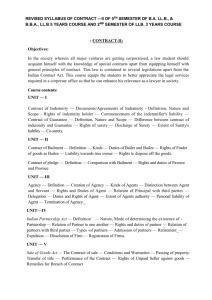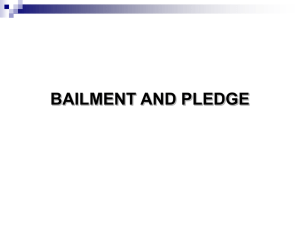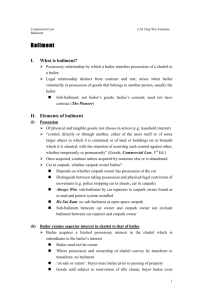34 Duty of Care to Lenders
advertisement
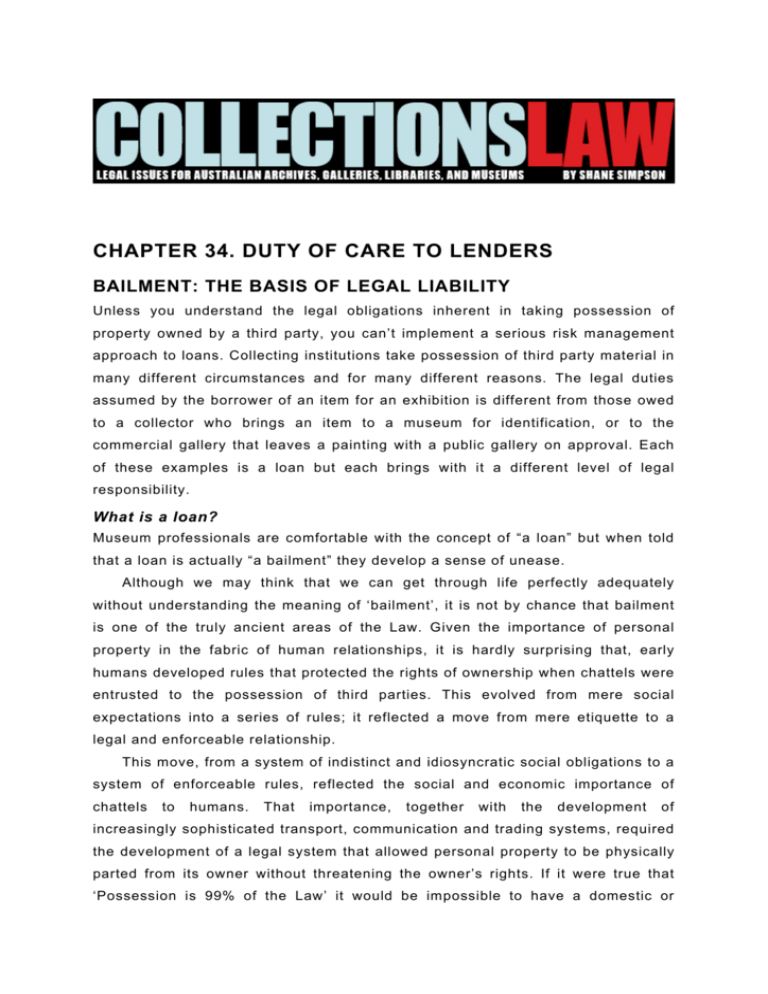
CHAPTER 34. DUTY OF CARE TO LENDERS BAILMENT: THE BASIS OF LEGAL LIABILITY Unless you understand the legal obligations inherent in taking possession of property owned by a third party, you can’t implement a serious risk management approach to loans. Collecting institutions take possession of third party material in many different circumstances and for many different reasons. The legal duties assumed by the borrower of an item for an exhibition is different from those owed to a collector who brings an item to a museum for identification, or to the commercial gallery that leaves a painting with a public gallery on approval. Each of these examples is a loan but each brings with it a different level of legal responsibility. What is a loan? Museum professionals are comfortable with the concept of “a loan” but when told that a loan is actually “a bailment” they develop a sense of unease. Although we may think that we can get through life perfectly adequately without understanding the meaning of ‘bailment’, it is not by chance that bailment is one of the truly ancient areas of the Law. Given the importance of personal property in the fabric of human relationships, it is hardly surprising that, early humans developed rules that protected the rights of ownership when chattels were entrusted to the possession of third parties. This evolved from mere social expectations into a series of rules; it reflected a move from mere etiquette to a legal and enforceable relationship. This move, from a system of indistinct and idiosyncratic social obligations to a system of enforceable rules, reflected the social and economic importance of chattels to humans. That importance, together with the development of increasingly sophisticated transport, communication and trading systems, required the development of a legal system that allowed personal property to be physically parted from its owner without threatening the owner’s rights. If it were true that ‘Possession is 99% of the Law’ it would be impossible to have a domestic or international trading system; we could not even leave our clothes at dry cleaners nor send our television out for repair. It would also be impossible for those seeking to mount an exhibition to borrow material from third parties. In short, bailment may not sound interesting but it is one of the essential oils that facilitate modern life. It is also the legal basis of all exhibition loans. The term ‘bailment’ comes from the French, bailier, to deliver. The bailor is the party who owns the material and delivers it into the possession of the bailee. The bailee is the party that receives the material. Types of bailment There are many different types of bailment and each type carries its own rights and obligations. Generally, they fall into three groups: those bailments that are principally for the benefit of the bailor, those that are principally for the benefit of the bailee and those where the benefit is mutual. Where the bailment is principally for the benefit the bailor the courts generally impose a slightly lighter burden of care on the bailee. In such cases the courts will usually require that the breach of care by the bailee must have involved ‘gross negligence’ rather than ‘mere negligence’. In contrast, where the bailment largely benefits the bailee 1, the court imposes a reasonably high duty in the care upon the bailee. 2 The law further makes distinctions between (i) bailment for reward, (ii) gratuitous bailment, and involuntary bailment. These distinctions are important because collecting institutions take possession of third party material in many different circumstances and for many different reasons. The legal duties assumed by the borrower of a work for an exhibition would be different from those owed to a collector who brings an item to a museum for identification or the commercial gallery that leaves a painting with a gallery on approval. 1. BAILMENT FOR REWARD A bailment for reward arises where goods are taken into custody in return for valuable and mutual consideration. The usual instance of this is where you hand 1 For example where an exhibition organiser accepts an inward loan for the purpose of the show, it bears the duty of due care. 2 The mere fact of possession does not automatically give rise to a bailment. Generally, a conscious and willing assumption of possession of the goods is required before bailment can exist: N E Palmer, Bailment (Law Book Co, 1979) at 1 and note 1 at 30. over goods for service or repair. 3 The bailment is for the mutual benefit of the parties. Where the bailment is for reward, the bailee is under a duty to deal with the goods with the due care and diligence which a careful person would exercise over their own chattels in similar circumstances. 4 Of course this is the very duty of care that is so commonly reflected in loan-in agreements. 2. GRATUITOUS BAILMENT A gratuitous bailment is one where just one party benefits. Usually a gratuitous bailee has permission to possess goods without payment or consideration but must return them to the bailor on demand. The duty of care owed by a gratuitous bailee is of a lower standard than required of a bailee for reward. If you lend a painting to your neighbour, that loan is almost certainly a gratuitous bailment. The neighbour’s duty of care is low and the loan can be recalled at any time. Similarly, a loan from one institution to another (without fee) is very likely a gratuitous bailment for the lending institution receives no payment or consideration for the loan. It is for this reason that institutions have loan agreements that stipulate a higher duty of care and include definite loan periods. 3. INVOLUNTARY BAILMENT This occurs where the goods are found 5 or left 6 without payment. This may occur where an object brought to a museum for identification is left uncollected. This bailment gives rise to the lowest standard of care of all. All the bailee must do is abstain from reckless or wilful damage 7 There is much case law discussing the limits and application of those terms but is clear from those cases that the courts take into account what is reasonable and proper in all the circumstances. As the NSW Law Reform Commission noted: 2.7 The scope of the duty of the involuntary bailee to abstain from wilfully damaging the goods varies widely according to the circumstances of the bailment. There is some authority for the proposition that there can be no legitimate complaint against a bailee who acts in a manner which is 3 The consideration would be mutual where, say, one party gets paid for the service and the other gets the promise that the goods will be repaired. 4 Coggs v Bernard (1703) 2 Ld Raym 909; 92 ER 107 per Holt CJ at 916; 111. 5 Which may be relevant where material is acquired through field trips. 6 For example, where an anonymous person leaves a valuable book outside the door of the library. Perhaps the most common example is where possession arises from ‘inertia selling’ – e.g. Readers Digest. 7 N E Palmer, Bailment, (Law Book Co, 1979) at Note 1 at 383; see also Elvin & Powell Ltd v Plummer Roddis Ltd (1933) 50 TLR 158. 8 considered ‘reasonable and proper’ in all the circumstances, including 9 the destruction of the goods if they have become a nuisance. Similarly, a bailee who acts with the object of either returning the goods or mitigating responsibility for them (whether by delivering them to the police or a bank, or by returning an unsolicited letter to the post office) incurs no liability to their owner. 2.8 However, the precise duties of an involuntary bailee, and the nature of the safeguards to be taken in disposing of the goods, remain illdefined and unsatisfactory due to the wide variety of goods and circumstances in which the involuntary bailee can acquire possession. 2.9 Logically the whole concept of involuntary bailment is a contradiction in terms. The term “bailment” implies both possession of another person’s goods and agreement to or acceptance of such possession. Involuntary bailment does not require a voluntary election by the bailee 10 to hold the goods. It has been argued that without this voluntary element there may not be a true relationship of bailor and bailee. 2.10 These problems are of particular importance in the present inquiry for they form the only part of the common law relating to unclaimed goods not superseded by the Disposal of Uncollected Goods Act. Involuntary bailees are thus the only bailees left without an effective remedy. The joy of contract Whilst the complexities of bailment will bring a smile to the lips of many lawyers, the wise collection manager will be one whose first question is not, ‘What are the rights and responsibilities of bailees and bailors?’ The much better question is, ‘What can I do so that I never have to think about the complexities of the law of bailment?’ The answer is remarkably simple. If the bailee and the bailor enter an agreement, the terms of that contract supersede the Common Law rules. Where the express terms of a contract impose a particular duty of care and level of responsibility, those are the obligations that prevail. However, if the contract is silent as to such matters, or is ambiguous, one must again revert to the complexities of the Common Law or statute. Chapter 16 focuses on the contractual aspects of bailment contracts. Of course in collecting institutions we call them loan agreements. LEGAL RESPONSIBILITY UNDER THE LOAN AGREEMENT 8 Hiort v Bott (1874) LR 9 Ex 86 at 91, per Cleasby B. 9 Winfield and Jolowicz, Torts (12th ed, Sweet & Maxwell, 1984) at 481. 10 Note 1 at 379. The approach of the English courts at least has been to deny that the involuntary recipient of goods is a bailee; see Lethbridge v Phillips (1819) 2 Stark 478. Australian authority is limited in this area, but see Alice Erh-Soon Tay, ‘The Essence of a Bailment: Contract Agreement or Possession?’ (1966) 5 Sydney LR 239, especially 248–57. One of the most important functions of the loan agreement is to define the standard of care that the borrower must fulfil. This creates a basic and natural tussle in that the lender will wish to impose high levels of legal responsibility on the borrower and the borrower, restricted by the extent and conditions of its insurance cover, will want to limit that liability. In art museums it is very common that the borrower promises the lender that it will take the same degree of care of the item as it give to items of a similar quality and nature in its own collection. 11 This clause imposes liability on the Exhibitor (the borrower) for the security of the work at all time from the time that the work is on its premises and in its possession. It includes specific promises that the borrower will abide by the security, staffing, environmental, conservational and handling requirements spelled out in detail in the Exhibits to the agreement. 12 11 For example see clause 4, Exhibition Agreement, Museum of Fine Arts, Boston: The Exhibitor will be responsible for the security of the Works at all time while on the Exhibitor’s premises, including during storage, unloading/loading, unpacking/repacking, installation/deinstallation and exhibition, and must take all appropriate and prudent measure to protect the Works and keep them secure while in their possession, at a minimum as they care for and secure works of art of the same or similar nature of their own, or on loan from others, including without limitation precautionary measures against risks of fire, theft, accidents, disasters, ultraviolet and visible light, incorrect relative humidity and temperature, environmental overcrowding in the galleries, and the dangers resulting there from. Specifically, the Exhibitor agrees to abide by the security, staffing and environmental conditions specified in Exhibit B or any special requirements for Works in the Exhibition that MFA may stipulate in writing in Exhibit C or at a later date. In addition, the Exhibitor agrees to comply with any special security, handling, care, or other requirements of Private Collector(s) which MFA will provide as soon as available. No off-site storage of any Work is allowed without advance written permission of MFA. Several Australian art museums, such as the AGNSW, use similar clauses. 12 Such administrative and technical matters are often best handled in schedules or annexures so that they do not make the body of the contract too impenetrable. The contract should make the principles of liability very clear: they will rarely change from borrower to borrower. The details, however, will often vary and this is best done in a Schedule so that the body of the contract does not get constantly amended. Note that the lender’s liability does not extend to transport: It is not ‘nail to nail’ liability. 13 The standard set is the rather self-satisfied standard: ‘at a minimum as they care for and secure works of art of the same or similar nature of their own, or on loan from others’. Even institutions of the first rank have had embarrassing experiences in the care and security of their own collection material and it is reasonable for lenders to insist that this watering down of liability be removed from the agreement. After all, the fact that institution A is prepared to accept a certain level of care towards its own collection material should not give institution B any particular succour. In the event of damage, loss or theft of the loan material, the owner should not have the legal obligation: • to prove the standard of care usually given by the borrower to similar material in its own collections; and • to prove that the standard of care given to the lender’s material was below the borrower’s usual standards. Both of these things are very arduous (and expensive) matters of proof and most lenders do not want to have to jump such legal hurdles before they can get to the real issues of liability. On the other hand, museums that include such phrases in their loan-in documentation are inadvertently exposing themselves to embarrassment and expense: In the event that a borrowed work is damaged or destroyed, unless the claim is settled to the satisfaction of the owner and its insurance company, any legal proceedings will result in an unfortunate public washing and airing of dirty linen as lawyers for the plaintiff obtain evidence of all the defendant’s embarrassing blemishes of collection management. In an age in which sponsorship and donations are so important to the balance sheet of collecting institutions, none can afford to be the subject of such adverse criticism. As a final observation, none of the museums that promise to look after inward loans with the ‘same standard as of care given to similar material in its own collection’ apply this standard when lending works to others. It is perhaps understandable that owners insist on a high standard of care whilst borrowers wish to work to a (lower) more flexible standard, but borrowers might find that there is a lot less negotiation (and thus time, cost and delay) if their loan-in contracts reflected the same standards of care as their loan-out agreements. 13 In this agreement the transport of the work is undertaken by the owner institution and therefore the lender’s liability only lasts from the time the work is delivered to the time the owner picks it up from the borrower’s premises.
